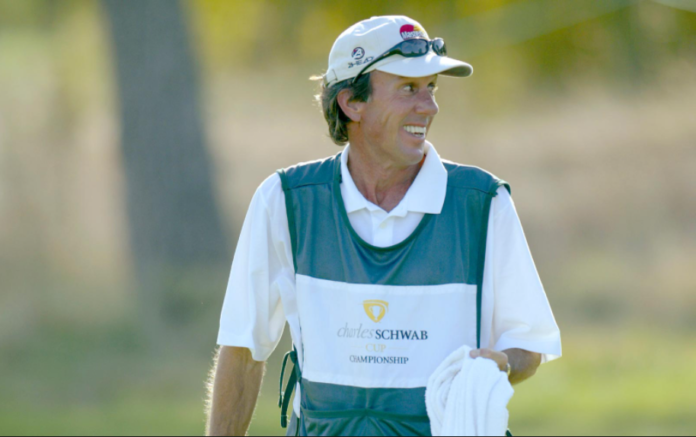
HARTFORD, Conn. – Bruce Edwards’ parents weren’t exactly keen on their free-spirited son leaving Wethersfield to caddie on the PGA Tour in 1973, even if it was supposedly only for a year.
Father Jay Edwards cracks up when he describes going to pick up Bruce after his first day of kindergarten, only to be told his son had been kept after school for misbehaving.
“How many kids get in trouble on their first day of kindergarten?” Jay said, laughing.
No, Jay and the late Natalie Edwards were hoping the second of their four children would become a doctor or a lawyer or a dentist, like his dad. But after Bruce became arguably the most famous and inspirational caddie in golf history while working for Hall of Famers Tom Watson and Greg Norman for more than three decades, they realized the gypsy at heart had made the right decision.
And Edwards’ parents and three siblings were especially proud of how Bruce handled his final months battling amyotrophic lateral sclerosis (ALS), commonly known as Lou Gehrig’s Disease, before succumbing at only 49 at 6:26 a.m. on April 8, 2004, the morning of the start of his favorite tournament, the Masters. It was only hours after his father accepted the Golf Writers Association of America’s Ben Hogan Award, given annually to an individual who continued to be active in golf despite a physical handicap or serious injury, on his son’s behalf at the organization’s annual awards dinner.
“Bruce truly loved what he was doing from his first day on Tour to the very end (in 2003),” said Jay Edwards, 92, a retired dentist now living in Vero Beach, Fla. “Thank God Bruce was always the kind of kid who stuck to his guns. Those first few years, we kept waiting for him to say ‘enough” and come home and go to college. Who knows, if he hadn’t ended up with Tom, maybe he would have come home, but I’m not sure.
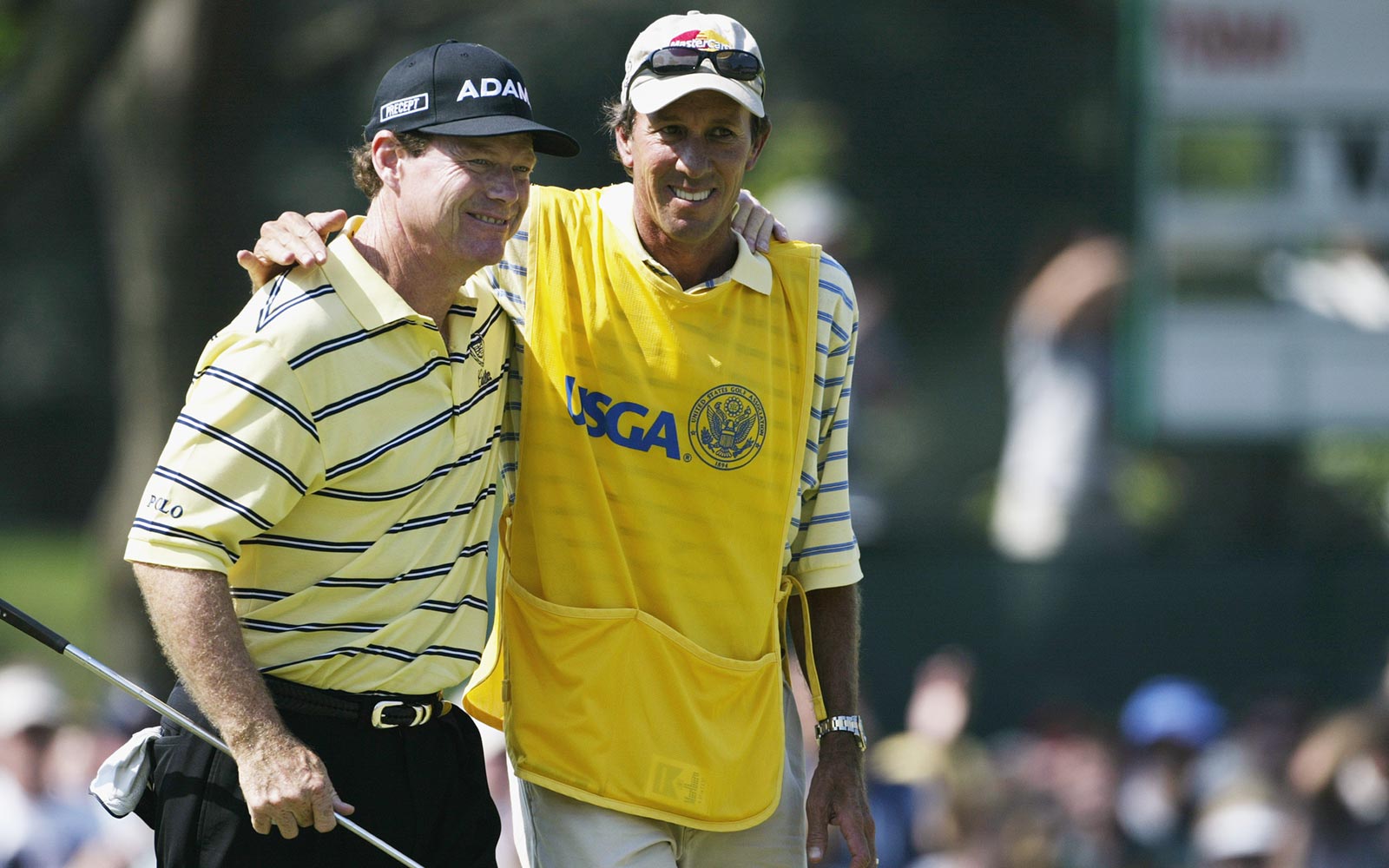
“Bruce loved the life out there. He made lots of friends, good friends, and he really found a niche doing what he was doing. He was right, we were wrong. I’m really proud of what he became.”
What Edwards became was a model of success and inspiration, which are major reasons why he and Travelers executive Andy Bessette will be inducted into the Connecticut Golf Hall of Fame at the Hartford Downtown Marriott on June 20, the start of Travelers Championship week.
And no one was more of a friend to Edwards than Watson, an eight-time major championship winner who continues to raise funds to fight ASL to this day. Watson once gave Bruce a new van as a Christmas present to help make travel on the PGA Tour more comfortable, but it was the support that Watson offered through Bruce’s final weeks that made their relationship so special.
Despite learning of Bruce’s death only hours after it happened, Watson knew he had to play the first round of the Masters because that’s what his longtime caddie/friend would have wanted.
After his round, Watson emotionally talked about Bruce for an hour and pledged to do everything in his power “to kill this damn disease.”
“Bruce Edwards, my caddie and good friend, didn’t have a mean bone in his body,” Watson said. “He was respected, admired and loved by many. His glass was always half full, never half empty. He did his job right, with an enthusiasm that was infectious to a lot of other caddies who became the core looper group on the PGA Tour, many of whom came out of the Hartford area.
“We always laughed at the life we both led, gypsies following the dream, me playing the PGA Tour and him carrying my bag. And indeed what a great life we shared together.”
Edwards was 12 when he first caddied in the Insurance City Open at Wethersfield Country Club along with younger brother Brian, who also went on to work on the PGA Tour. When Bruce graduated from Marianapolis Prep in Thompson, he decided to try working on the PGA Tour, becoming the only one of the 39 members of his high school class who didn’t head for college. He initially worked for David Graham at the Kemper Open in Charlotte, N.C., and then was caddying across the country when he found himself outside the locker room at the St. Louis Children’s Hospital Golf Classic six weeks later. He saw “a long-haired golfer” in the parking lot and asked Watson if he could work for him. Tom said he could have a tryout for a week, and they would see what transpired.
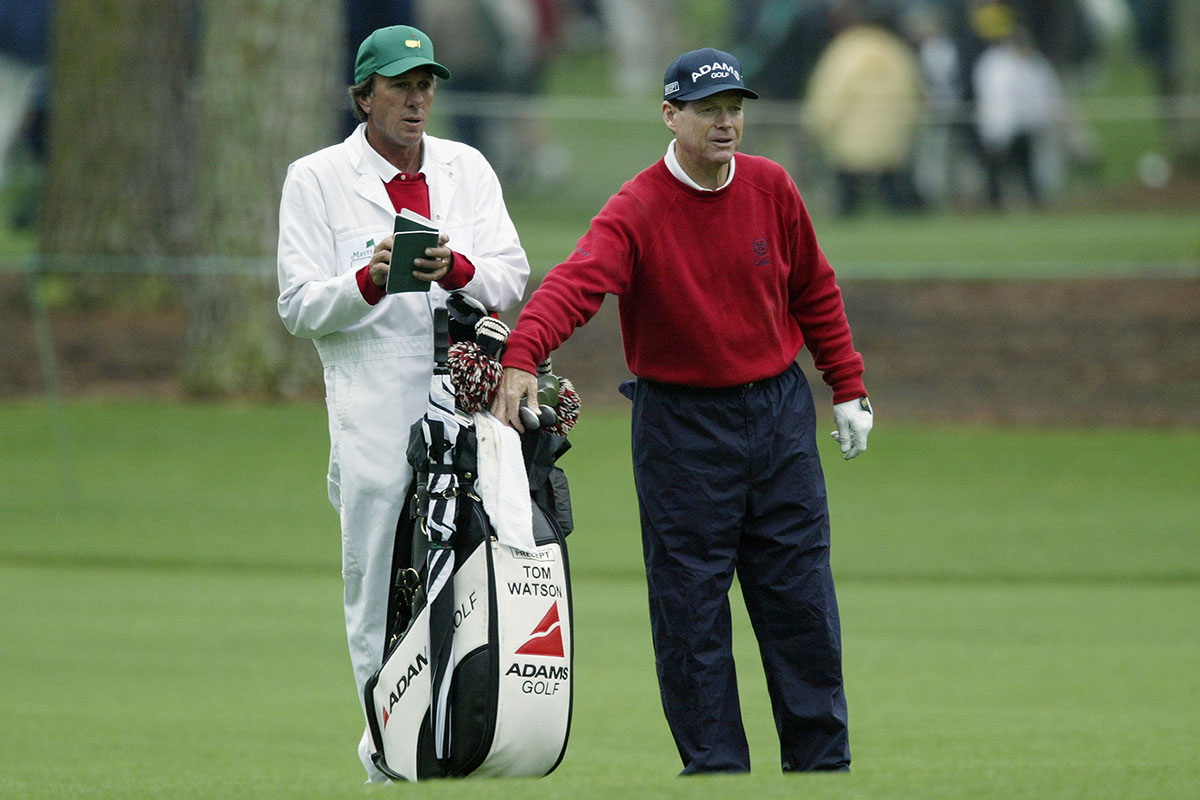
Watson finished sixth and immediately took a liking to Edwards’ enthusiasm, work ethic and attention to detail and said they could continue to be a team. Their partnership lasted until 1989, and they won 35 PGA Tour events, though Bruce was on Tom’s bag for only one of his eight major championships due to caddie regulations.
When Watson began to cut back his schedule, he encouraged Edwards to accept an offer from Norman, then the No. 1 ranked player in the world who won the 1995 Canon Greater Hartford Open. Edwards worked for Norman for three years before returning to Watson in 1992, and the duo continued together again until Edwards was diagnosed with ALS during a visit to the Mayo Clinic in Rochester, Minn., and told he had one to three years to live.
Edwards spent much of his final 15 months doing interviews about what he was dealing with because it wasn’t in his nature to say no to people and to raise awareness about the disease. And, in doing so, he helped raise money for research, if not in time to save his life then perhaps to save others. He did it all with a grace and courage that had made him into a heroic figure to many, not a role that Bruce wanted or felt he deserved. But he accepted it as part of what he was going through.
“A lot of people described the last few months as bittersweet for Bruce and me,” Watson said as the end neared. “I can honestly say it’s a lot more bitter than sweet. A lot more.”
Edwards’ younger sister, Gwyn Dieterle, 59, is a mother of three who works in marketing for AAA Northeast, lives in Franklin, Mass., and called her late brother “a free spirit.” She recalls him escaping from his bedroom window when grounded in his room and having his hair long, smoking cigarettes and wearing classic 1970s clothes such as a leather, covered-in-fringe jacket.
“My parents were challenged by his rebellious spirit, my sister and he were as opposite as siblings can be and he and my brother shared a bedroom for a while that led to more than a few ‘disagreements,’ ” Gwyn recalled. “However, I thought Bruce was the coolest brother ever. He was self-assured — no one could pull off that fringed leather jacket like he could — witty and outgoing. When I attended tournaments in which he was caddying, be it the GHO, Westchester (N.Y) or Pleasant Valley (in Sutton, Mass.), he’d make it a point to come over to me and chat and give my friends a golf ball or some other item. I loved the attention, hoping some of that coolness rubbed off on me.”
Gwyn said Bruce needed to be out and about, and the PGA Tour was the perfect space for him. She always admired he knew himself well enough and found his way despite a lot of naysayers. He always knew he would make it, not because he was “luckier” than others but because he had the confidence, personality and drive to succeed.
“I think when he left Wethersfield, he knew he’d never come back again,” Gwyn said. “One of his best qualities was his ability to choose his friends well. Some of his best friends were the local kids he hung out with in Connecticut — Gary Crandall, Billy Leahey, Dennis Turning. Gary and Billy, along with Drew (Micelli) and Neil (Oxman), who still are regulars at any Bruce Edwards Foundation fundraisers and keep in touch with my dad regularly. They are the best guys, and it takes a skill to seek out people who will remain loyal to you through thick and thin.”
When Gwyn found out Bruce was diagnosed with ALS, she couldn’t bring herself to call him right away so she wrote a lengthy email.
“The subject line was ‘Love and Prayers,’ and when he responded, he changed it to ‘Love and Prayers … and the Eagles,” Gwyn said, referring to Bruce’s favorite NFL team. “It made me laugh and made me cry because it was just so classic Bruce, trying not to dwell on the negatives and wrap in some humor instead. I think he lived his life — and handled ALS — in the same way.”
Bruce loved Philadelphia teams and threw out the first pitch at a Phillies game. He became friends with Hall of Fame third baseman Mike Schmidt through pro-ams and got tickets from him when he was in town. At Bruce’s funeral, the Eagles sent official home jerseys for all of the golfers and caddies who attended with E-D-W-A-R-D-S on the back. And the jersey on Bruce’s casket was an away Eagles jersey, also with his name on it.
Brian Edwards, 64, is a retired endodontist living in Steamboat Springs, Colo., who also was among several caddies from Wethersfield CC to work on the PGA Tour. He carried mostly for Tom Purtzer and Jack Renner, who finished second to Jerry McGee in the 1979 Greater Hartford Open and won the 1981 Pleasant Valley Jimmy Fund Classic at Pleasant Valley Country Club. Ironically, brother Bruce was on the bag when Isao Aoki holed a 128-yard wedge shot for eagle 3 on the final hole to beat Renner in the 1983 Hawaiian Open.
When Brian thinks of Bruce, it’s how he overcame great odds, at least in the minds of their parents, to become the success he did.
“He was never officially diagnosed as ADHD, but clearly he fit the bill,” Brian said. “In the eyes of my parents, the path to making something of oneself was to study hard, work hard and exhibit discipline. He never accepted that path, and, in fact, frankly rejected it, everyone else be damned. It makes his achievements and admiration by some of the most respected names in golf so startling. Cue Frank Sinatra’s ‘My Way.’ And now his induction into the Hall of Fame supports his claim that there are alternate ways to success. I can hear him now say, ‘I told you.’”
Edwards’ life was chronicled in author John Feinstein’s best-selling book, “Caddy for Life: The Bruce Edwards Story.” He and Watson formed the Bruce Edwards Foundation for ALS Research that has raised more than $10 million, including $1.1 million from a dinner in Hartford that drew more than 1,000 people after the second round of the 2016 Travelers Championship. Three-time Travelers Championship winner Bubba Watson donated $100,000 and was among dozens of players and caddies to attend the event.

Feinstein was the master of ceremonies, and speakers included Watson, PGA Tour commissioner Tim Finchem, CBS announcer Jim Nantz and Travelers executive chairman of the board Jay Fishman, who died of ASL two weeks after the tournament.
“I learned a lot of lessons from Bruce and Tom about friendship and loyalty,” Feinstein said. “A lot of people use those words, but those guys lived them.”
Edwards and some of his contemporaries such as brother Brian, Joe LaCava of Newtown, Glastonbury’s Greg Rita and Newington’s Gypsy Grillo helped change the image of the PGA Tour caddie from irresponsible hangers-on to respected partner. Bruce and LaCava, who has been on the PGA Tour for more than 30 years and now caddies for Tiger Woods, are members of the Caddie Hall of Fame.
Edwards became a role model for young caddies, taking many under his wing when they first came on Tour and taught them the do’s and don’ts of the trade.
“He was the Arnold Palmer of caddies,” said Jim “Bones” Mackay, another member of the Caddie Hall of Fame who worked for two-time GHO champion Phil Mickelson for 25 years and is now with Justin Thomas.
Edwards’ relationship with Watson was built on many things, not the least of which was Bruce’s willingness to disagree with his boss, even challenge him at times. Watson had enough self-confidence that he didn’t mind being told he was wrong, and the two argued often but almost never really fought. Bruce always gave most of the credit for their relationship to Watson.
Watson was Bruce’s best man in his second marriage in Hawaii, attended by dozens of players and caddies on the PGA Tour Champions, including Arnold Palmer, Jack Nicklaus and Gary Player. Bruce’s first marriage ended in 2001 after his wife burned down their Florida home, was found guilty of arson and sentenced to 15 years of community supervision. No one was injured in the blaze, but Edwards lost most of his golf memorabilia, a preview of what it’s like to be an object of sympathy.
The overwhelming feeling of those who knew and loved Bruce Edwards is they were proud of what he had accomplished, the man he had become and how he had always done it on his own terms. And mostly, they were proud and amazed by his ability to keep his sense of humor and upbeat approach to every day, even when so much of the future looked so terribly bleak.
And if nothing else, Bruce never stopped being Bruce.
“First and foremost, Bruce Edwards was a caddie,” Watson said. “He loved to be inside the ropes caddying for the pros, and I’m mighty thankful that I was a part of that.”




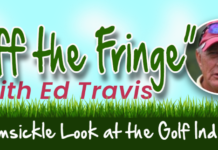





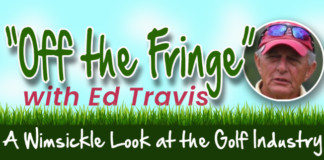
Leave a Reply